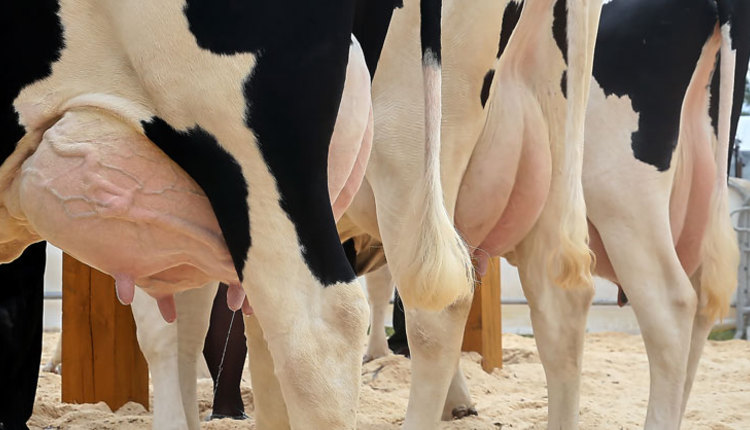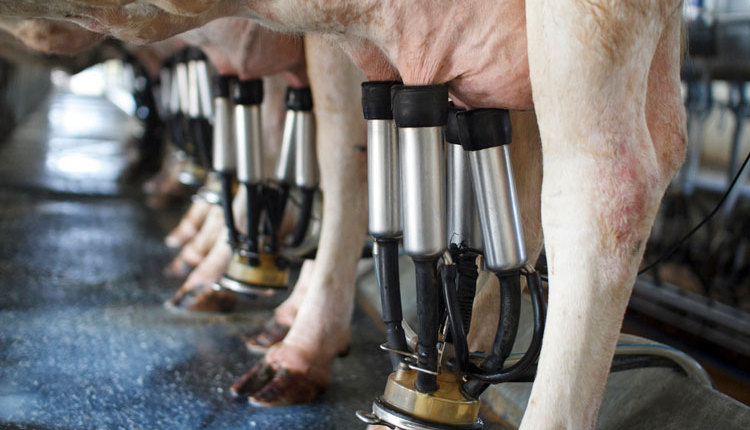The authors are with Quality Milk Production Services, Cornell University.
Proper premilking udder stimulation is indispensable to harvesting high-quality milk from cows as quickly and completely as possible while minimizing the impact of the milking machine on teat and udder health. Premilking stimulation is essential for activating the milk-ejection reflex to obtain the alveolar milk, which represents approximately 80% of the udder’s milk volume.
Two key steps
Premilking stimulation includes tactile stimulation and milking unit attachment timing. Through activation of pressure-sensitive mechanoreceptors located primarily in the tip of the teat, tactile stimulation initiates release of oxytocin from the brain into circulation. The timing of the milking unit attachment provides enough time for this hormone to reach the mammary gland via the blood and stimulate receptors of myoepithelial cells. Their contraction leads to forceful mechanical ejection of the alveolar milk into the duct system, which makes it available for harvest.
Adequate stimulation a must
Current recommendations suggest a minimum duration for tactile stimulation of 10 to 20 seconds and a time interval between the start of stimulation and milking unit attachment between 90 and 150 seconds. However, according to a recent Michigan State University study, 32 out of 64 dairy herds (50%) applied stimulation for a very short duration of six seconds or less. This is consistent with data from our own group showing that the average duration of stimulation ranges from three to six seconds on New York dairy farms.
Consequently, the physiological requirements of dairy cows are not met in most current milking systems. This hampers the ability to elicit the cows’ maximum milk ejection capacity, leading to delayed milk ejection. Delayed milk ejection has been associated with poor milking efficiency and reduced milk yield. Results from recent studies show that cows with delayed milk ejection produce 3 to 7 pounds less milk per milking compared to cows without delayed milk ejection.
On-farm assessment
Delayed milk ejection is most often presented as bimodal milk ejection resulting in a bimodal milk flow curve. A bimodal milk flow curve is characterized by an early increase in milk flow rate followed by a reduced milk flow rate during the first two minutes of milking . . . as such, two milk flow peaks occur. The reduction can materialize as a partial or complete cessation of milk flow and, more practically, may be identified as an “empty or dry claw” shortly after milking unit attachment. Delayed milk ejection is less than ideal as incomplete milking is the end result.
Traditionally, bimodality has been assessed with a portable milk flow meter (the Lactocorder, WMB AG, Balgach, Switzerland) that measures continuous milk flow. Indeed, the Lactocorder is highly popular among veterinarians and milk quality consultants and has been considered the gold standard for the field assessment of bimodality in dairy cows. More recently, researchers have used the inverse relationship between milk flow and vacuum to indirectly assess bimodality with a portable vacuum recording device (VaDia vacuum recorders, Biocontrol, Rakkestad, Norway). They found it to be a suitable measure for the assessment of bimodality.
Over recent decades, on-farm milk flow meter technology has substantially advanced, and the milk flow characteristics of individual cows can be recorded in greater accuracy. Specifically, several electronic on-farm milk flow meters from various manufacturers are now able to calculate and record incremental milk flow rates during 0 to 15, 15 to 30, 30 to 60, and 60 to 120 seconds in milking observations of individual cows. This offers a unique opportunity to collate these automatically recorded incremental milk flow rates and identify cows with bimodal milk flow curves.
Given this opportunity, we recently set out to do the following:
1. Develop a protocol to identify cows that show repeatedly bimodal milk ejections.
2. Investigate risk factors of repeated bimodality.
3. Assess possible differences in milk production between cows with and without bimodal milk ejections.
Steps in the process
We collected milk flow data over a one-week period from a large dairy with a rotary milking parlor and a three times (3X) per day milking schedule. During the first step, we identified cows that experienced a bimodal milk ejection 21 times out of 21 possible milking observations. Cows that had no record of a bimodality were selected as the comparison group. Second, we investigated factors that put cows at risk of repeated bimodality. We found that cows in the presented herd were at a higher risk of recurrent bimodality if they:
• Were in lactation 1 or 2
• Were later than 200 days in milk
• Had a lameness event during the study period
• Had a vaccination event one week prior to the study period
In the third step, we explored the question whether recurrent bimodality is associated with a notable loss in milk production for the farm. For this purpose, we looked at the average daily milk yield of cows with and without bimodality during the 21 milking observations over the course of the one-week period.
We found an interaction between parity and bimodality such that differences between cows with and without bimodality were larger for cows in the third lactation and greater compared with first lactation cows or cows in lactation 2 (see figure). For example, we estimated that the average daily milk production was 85 pounds for a first lactation cow without bimodality (BIMODAL-0) and 78 pounds for a first-lactation cow with 21 out of 21 bimodal milking observations (BIMODAL-21). This compares to an average daily milk production of 107 pounds for a third or greater lactation cow without bimodality and 77 pounds for a mature cow that showed a bimodal milk flow curve at each of the 21 milking observations.

Concluding thoughts
Incremental milk flow rates automatically obtained from electronic on-farm milk meters could serve as a useful tool to identify cows with delayed milk ejection. This knowledge could help identify potential risk factors, including health and management events that are associated with delayed milk ejection. It could also help us develop informed premilking udder preparation regimens to meet the animal´s physiological requirements, and ultimately, enhance milk efficiency and possibly milk production.









